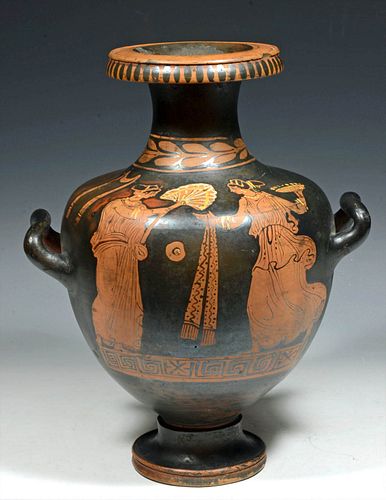Greek Apulian Red Figure Hydria, Ladies of Fashion
Lot 26
About Seller
Artemis Fine Arts
686 S Taylor Ave, Ste 106
Louisville, CO 80027
United States
Selling antiquities, ancient and ethnographic art online since 1993, Artemis Gallery specializes in Classical Antiquities (Egyptian, Greek, Roman, Near Eastern), Asian, Pre-Columbian, African / Tribal / Oceanographic art. Our extensive inventory includes pottery, stone, metal, wood, glass and textil...Read more
Categories
Estimate:
$16,000 - $24,000
Absentee vs Live bid
Two ways to bid:
- Leave a max absentee bid and the platform will bid on your behalf up to your maximum bid during the live auction.
- Bid live during the auction and your bids will be submitted real-time to the auctioneer.
Bid Increments
| Price | Bid Increment |
|---|---|
| $0 | $25 |
| $300 | $50 |
| $1,000 | $100 |
| $2,000 | $250 |
| $5,000 | $500 |
| $10,000 | $1,000 |
| $20,000 | $2,500 |
| $50,000 | $5,000 |
| $100,000 | $10,000 |
| $200,000 | $20,000 |
About Auction
By Artemis Fine Arts
Mar 24, 2022
Set Reminder
2022-03-24 10:00:00
2022-03-24 10:00:00
America/New_York
Bidsquare
Bidsquare : Exceptional Antiquities Ethnographic Fine Art
https://www.bidsquare.com/auctions/artemis-gallery/exceptional-antiquities-ethnographic-fine-art-9057
Museum-worthy examples of classical antiquities (Egyptian, Greek, Roman, Near Eastern), Viking, Far East / Asian, Pre-Columbian, African / Tribal, Oceanic, Native American, Spanish Colonial, Fossils, Ancient Jewelry, Fine / Visual Arts, so much more! Artemis Fine Arts info@artemisgallery.com
Museum-worthy examples of classical antiquities (Egyptian, Greek, Roman, Near Eastern), Viking, Far East / Asian, Pre-Columbian, African / Tribal, Oceanic, Native American, Spanish Colonial, Fossils, Ancient Jewelry, Fine / Visual Arts, so much more! Artemis Fine Arts info@artemisgallery.com
- Lot Description
Ancient Greece, Magna Graecia, South Italy, Apulian, ca. 4th century BCE. A magnificent pottery hydria, meticulously hand-painted with red-figure technique of 2 ladies of fashion. Boasting lustrous black glaze on a red ground with white and orange fugitive paints, the stately vessel possesses a graceful presentation with a voluminous body, a dramatically sloped shoulder, a narrow neck, and a broad, flared rim, all sitting upon a discoid, pedestal foot. A pair of upward-swooping handles flank the body, both lying just below the shoulder edge. One side of the ancient hydria boasts a luxurious scene of 2 confronting ladies dressed lavishly, each draped in a flowing peplos comprised of cascading billows of rich fabric that highlight their slender figures. The woman on the left wears a himation over her peplos as she leans slightly inward and raises a crescent-shaped fan with both hands before her companion who steps toward her, holding out a lengthy sash in her right hand and a shallow dish behind her, in her left. Size: 9" Diameter x 12" H (22.9 cm x 30.5 cm)
An additional sash hangs behind the woman holding the fan. The epitome of opulence; both ladies are elaborately embellished by bracelets, arm bands, necklaces, earrings, fillets, and hair adornments. A petite eye design floats in the air between the 2 females - eyes were commonly painted on Greek vessels to serve an apotropaic function. The scene is flanked by a horizontal band of stopped meander motif below them and a horizontal register of laurel leaves above. Vertical striations further decorate the periphery of the rim.
Perhaps the most exciting innovation in Greek vase painting was the red-figure technique, invented in Athens around 525 BCE and beloved by other artists of Magna Graecia. The red-figure technique allowed for much greater flexibility as opposed to the black-figure technique, for now the artist could use a soft, pliable brush rather than a rigid metal graver to delineate interior details, play with the thickness of the lines, as well as build up or dilute glazes to create chromatic effects. The painter would create figures by outlining them in the natural red of the vase, and then enrich these figural forms with black lines to suggest volume, at times perspectival depth, and movement, bringing those silhouettes and their environs to life. Beyond this, fugitive pigments made it possible for the artist to create additional layers of interest and detail as we see in this example.
Cf. Beazley Archive at University of Oxford, 554 and 6260.
Provenance: private New York, New York, USA collection; ex-private Virginia, USA collection, acquired in the 1990s
All items legal to buy/sell under U.S. Statute covering cultural patrimony Code 2600, CHAPTER 14, and are guaranteed to be as described or your money back.
A Certificate of Authenticity will accompany all winning bids.
PLEASE NOTE: Due to recent increases of shipments being seized by Australian & German customs (even for items with pre-UNESCO provenance), we will no longer ship most antiquities and ancient Chinese art to Australia & Germany. For categories of items that are acceptable to ship to Australia or Germany, please contact us directly or work with your local customs brokerage firm.
Display stands not described as included/custom in the item description are for photography purposes only and will not be included with the item upon shipping.
#170402Body intact with stable fissure. Repair to 1 handle with restoration over break lines. Minor chip to rim. Expected nicks and scratches, commensurate with age. Fading to black glaze on verso. Otherwise, intact and excellent with impressive remaining pigments and detail. Old collection labels on underside of foot.Condition
- Shipping Info
-
All shipping is handled in-house for your convenience. Your invoice from Artemis Gallery will include shipping calculation instructions. If in doubt, please inquire BEFORE bidding for estimated shipping costs for individual items.
-
- Buyer's Premium



 EUR
EUR CAD
CAD AUD
AUD GBP
GBP MXN
MXN HKD
HKD CNY
CNY MYR
MYR SEK
SEK SGD
SGD CHF
CHF THB
THB




















